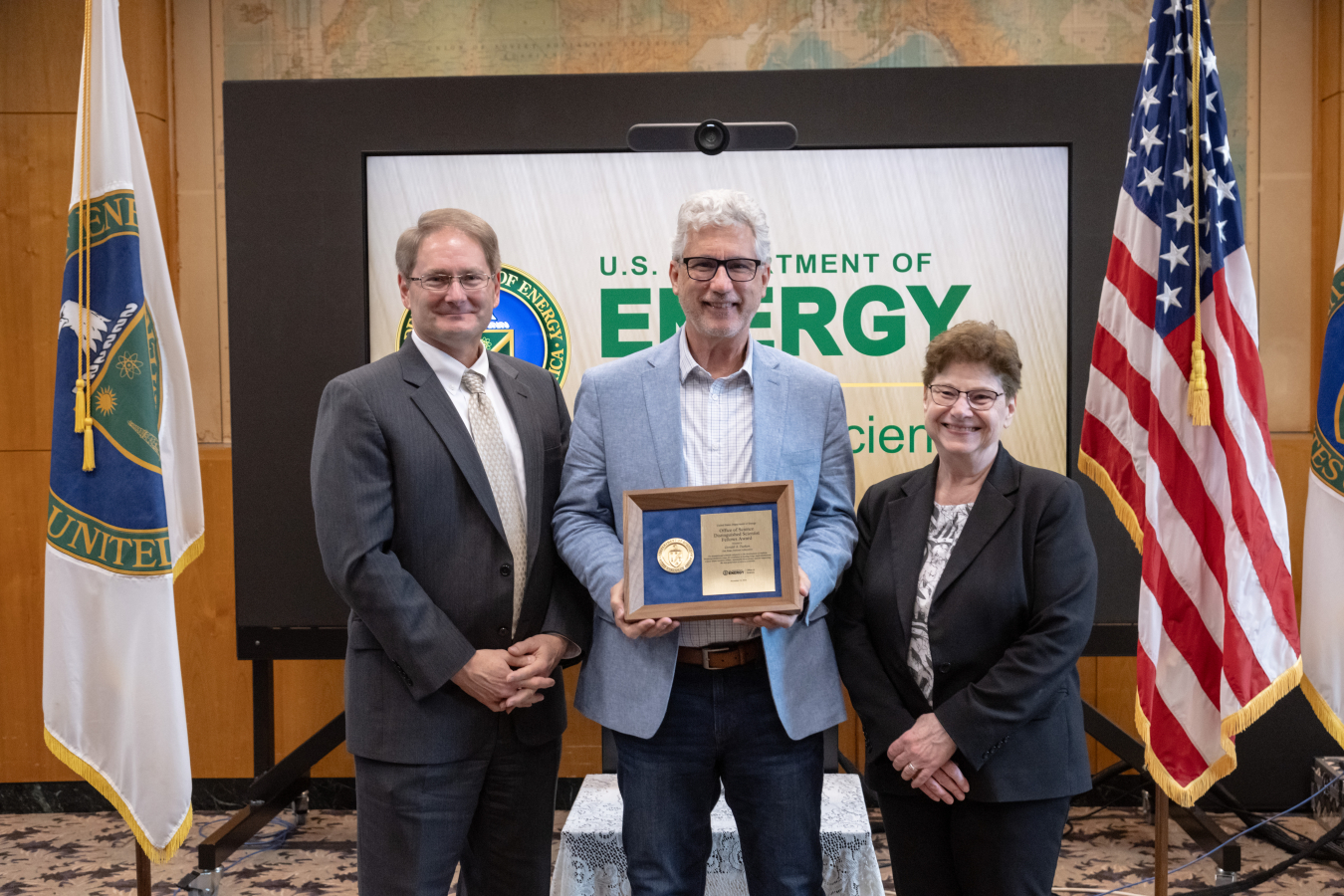Distinguished Scientist Fellow Gerald Tuskan shares his reflections on a career investigating the genetics of the poplar tree.
March 20, 2025Scientists recognized by the Department of Energy Office of Science Distinguished Scientists Fellows Award are pursuing answers to science’s biggest questions. Gerald Tuskan is the Director of the DOE Center for Bioenergy Innovation at Oak Ridge National Laboratory (ORNL).
Seventy million years ago, an asteroid blasted down from the sky. It smashed into southern Mexico, creating one of the biggest extinction events in Earth’s history. Along with the dinosaurs, it wiped out a large amount of early plant life. Ferns and other plants like pines were devastated. But this event also opened many ecological niches. One tree evolved to fill in one of these niches – Populus.
Following that dramatic event, the earliest versions of Populus show up in the fossil record 44 million years ago. Currently, Populus as a plant genus includes more than 30 species. These species include many common trees like poplar, aspen, and cottonwood.
My research reaches backwards millions of years into ecological history for inspiration and looks forward to a future bioeconomy. I work to answer the question: What can we learn from poplar trees to help us solve problems that range from fuel and materials production to radioactive cleanup?
Populus throughout history
Currently, Populus trees make up the fastest growing temperate woody species in North America. They also occur in Asia and Europe, with their habitat encircling the globe.
Populus trees are one of the most genetically diverse sets of organisms on Earth. As Populus is an undomesticated species, humans have access to all of the tree’s natural variation that has ever existed. As a result, Populus trees have many characteristics that could be useful for producing bioenergy and biochemicals.
While poplar lends itself well to modern uses, it has long held important roles in human society. The Romans made their cities livable in the hot Italian sun by planting poplar trees. By planting simple unrooted sticks throughout the Roman empire, they grew extensive urban forests. Napolean’s engineers took a similar tactic to mark the roads to Russia in the winter. Those poplar-lined boulevards still exist today. For thousands of years in North America, Indigenous tribes carved canoes out of cottonwood trees, a method replicated by the Lewis and Clark expedition.
Seeking to understand poplar’s genome
My own love of poplar started in camping trips with my dad and brothers. Along the Verde River in central Arizona, we slept under a massive cottonwood tree. As a forestry major at Northern Arizona University, I took a genetics class that opened my eyes to the potential of using genes to understand plants. My scientific path eventually combined the two.
From the beginning of my career, it was clear that genetics would be the key to unlocking poplar’s potential. In the early 1990s, poplar rose to the top as a potential source for bioenergy and biofuels. Of the plants we tested at DOE’s Oak Ridge National Laboratory, poplar was the fastest growing and one of the best to convert into fuel.
This potential led us to a major breakthrough – sequencing the first tree genome. Not long after the human genome had been sequenced, DOE was looking for ways to use this new technology. At a meeting, we pitched the idea of sequencing the poplar genome to Ari Petrinos – the geneticist leading the DOE effort. Craig Venter, who headed the private sector side of the Human Genome Project, slammed his hand on the table and said, “Ari, that’s the one you should do!”
In 2006, we sequenced the first full poplar genome. With the resources at DOE’s Joint Genome Institute Office of Science user facility, it was the first plant genome assembled using a technique called shotgun sequencing. Previously, scientists would clone DNA into bacterial chromosomes. These bacteria would multiply the DNA. The shotgun approach allowed us to skip several steps by isolating DNA from leaf tissue. This approach is now the universal way to sequence plant genomes.
We revealed another breakthrough in this study as well – but it was hidden in the paper’s appendix. Along with the plant’s DNA, we isolated and sequenced microbial genes found in poplar’s leaves and roots. We identified many different types of bacteria, archaea, and fungi living in the plant tissue. Scientists knew that plants had intimate relationships with microbes in the soil. But the idea of microbes living directly in the tissues was just too much. The reviewers told us, “Plants don’t have that many microbes in their tissues. It's just not possible.” The data ended up buried at the end of the paper. But 20 years later, other studies have shown that every single one of those microbes regularly live inside of poplar.
After sequencing poplar’s genes, we took what we learned from that project and applied it widely. As both switchgrass and eucalyptus have great promise, we sequenced those as well. We also created a common garden of Populus using the same technique as the Romans – planting bare sticks. With that simple approach, we developed the most informative, high-resolution genetic library of any plant species that’s publicly available. This resource has allowed us to link a single DNA mutation to plants’ physical characteristics. This development allowed us to identify genes relating to bioenergy and the bioeconomy. That set us on a new path of discovery.
Learning from nature
Since then, we’ve found a number of genes directly related to plant growth. One in particular controls lignin. Lignin is the biological glue that holds together cell walls. When it evolved millions of years ago, there was nothing that could break down lignin. As the layers of dead plant tissue accumulated, lignin remained and formed the carbon layer that makes up coal. Lignin deposits were so abundant that parts of the planet looked black from outer space. Eventually, a fungus evolved that could break down lignin.
Today, we use the same enzyme to break down lignin that these fungi use. Already, our research has led to raw material from lignin and other plant-based molecules that can be used in jet fuel, plastic precursors, and packaging materials. Controlling lignin’s growth could make it more efficient to produce such products.
Another gene in Populus allows certain fungi to colonize plants’ roots and promote growth. As scientists initially thought there was a vast collection of genes that determine symbiotic relationships, it was a surprise to find a single gene acts as a gatekeeper.
Yet another Populus gene is a bizarre combination of bacteria and ant DNA that regulates photosynthesis. Having this gene express itself more than normal resulted in 200 percent increases in productivity in the greenhouse. We are currently looking at how genes direct responses to drought, nitrogen use, and pathogen defense.
Surprising solutions
In addition to making biofuels and biomaterials, Populus trees could help us solve other problems as well. In research after a wildfire at Yellowstone National Park, we saw aspens growing back. Aspen regeneration hadn’t occurred there for 100 years. We were able to demonstrate that the overall genetic health of aspen had been improved by the new seedling occurrence. As aspen is a keystone species, these plants were key to the park’s recovery.
In Ukraine, we saw a different way that Populus could help. Poplar and willow have an affinity for the radioactive elements cesium and strontium. The Chernobyl nuclear accident in 1986 released huge amounts of these elements. They contaminated the river that provides water for the cities of Odessa and Kiev. In collaboration with universities, we ran experiments to see if Populus could help prevent water contamination.
Discoveries in Populus have even provided insights into human health. A study of the unorganized rapid division of plant cells revealed new insights into cancer. Plants use rapid cell growth to heal wounded bark. These same genes in humans are involved in developing testicular, pancreatic, and other cancers.
The Populus genus of trees has lasted millions of years and made huge impacts on human civilization. I look forward to finding out what we can learn next about this amazing tree.
Watch Gerald Tuskan’s Distinguished Scientist Fellow acceptance speech on the Office of Science’s YouTube channel.
Shannon Brescher Shea

Shannon Brescher Shea (shannon.shea@science.doe.gov) is the social media manager and senior writer/editor in the Office of Science’s Office of Communications and Public Affairs. She writes and curates content for the Office of Science’s Twitter and LinkedIn accounts as well as contributes to the Department of Energy’s overall social media accounts. In addition, she writes and edits feature stories covering the Office of Science’s discovery research and manages the Science Public Outreach Community (SPOC). Previously, she was a communications specialist in the Vehicle Technologies Office in the Office of Energy Efficiency and Renewable Energy. She began at the Energy Department in 2008 as a Presidential Management Fellow. In her free time, she enjoys bicycling, gardening, writing, volunteering, and parenting two awesome kids.



